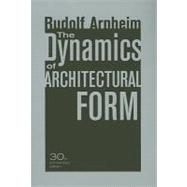
The Dynamics of Architectural Form
by Arnheim, RudolfBuy New
Buy Used
Rent Textbook
eTextbook
We're Sorry
Not Available
How Marketplace Works:
- This item is offered by an independent seller and not shipped from our warehouse
- Item details like edition and cover design may differ from our description; see seller's comments before ordering.
- Sellers much confirm and ship within two business days; otherwise, the order will be cancelled and refunded.
- Marketplace purchases cannot be returned to eCampus.com. Contact the seller directly for inquiries; if no response within two days, contact customer service.
- Additional shipping costs apply to Marketplace purchases. Review shipping costs at checkout.
Summary
Author Biography
Table of Contents
| Introduction | p. 1 |
| Elements of Space | p. 9 |
| Space created by things | p. 9 |
| Architectural implications | p. 13 |
| The fields in between | p. 16 |
| Empty and forlorn | p. 20 |
| The dynamics of surrounding space | p. 25 |
| Vertical and Horizontal | p. 32 |
| Asymmetrical space | p. 32 |
| Vision takes to the upright | p. 35 |
| Piercing the ground | p. 39 |
| Horizontality | p. 44 |
| Weight and height | p. 46 |
| Dynamics of the column | p. 48 |
| The plan and the section | p. 53 |
| The second and third dimensions | p. 57 |
| The mind adds the meaning | p. 64 |
| Solids and Hollows | p. 67 |
| Buildings in context | p. 67 |
| Boundless ground | p. 68 |
| The interplay of spaces | p. 69 |
| The street as figure | p. 76 |
| Crossings and squares | p. 81 |
| Crossings in churches | p. 87 |
| Inside and outside | p. 91 |
| Concavity and convexity | p. 94 |
| Interiors interrelated | p. 100 |
| Looking from both sides | p. 101 |
| As It Looks and As It Is | p. 110 |
| Perceiving a solid | p. 110 |
| Perspective deformations | p. 112 |
| The thread of Ariadne | p. 114 |
| The reading of vistas | p. 117 |
| Models and sizes | p. 122 |
| The range of images | p. 127 |
| The parts of the whole | p. 130 |
| The building made visible | p. 134 |
| Obliqueness and depth | p. 138 |
| Mobility | p. 144 |
| The autonomy of containers | p. 144 |
| Dignified immobility | p. 146 |
| Shelter and burrow | p. 148 |
| Motor behavior | p. 151 |
| The dynamics of the channel | p. 155 |
| Order and Disorder | p. 162 |
| Contradiction is a flaw | p. 162 |
| The constraints of order | p. 164 |
| Three modifications of order | p. 165 |
| How to make noise | p. 169 |
| Disorder, its causes and effects | p. 171 |
| Levels of complexity | p. 178 |
| The Porta Pia | p. 183 |
| Interaction of shapes | p. 188 |
| Balancing elements | p. 193 |
| The range of orders | p. 198 |
| Different functions, different orders | p. 201 |
| Symbols Through Dynamics | p. 205 |
| Visual labels | p. 206 |
| Symbolism | p. 207 |
| Inherent expression | p. 210 |
| The artifact in nature | p. 213 |
| Is it sculpture? | p. 217 |
| Dynamic proportions | p. 220 |
| The openness of buildings | p. 225 |
| Expansion from a base | p. 233 |
| Cefalù in three dimensions | p. 239 |
| The dynamics of arches | p. 242 |
| Expression and Function | p. 248 |
| Ornament and beyond | p. 248 |
| Expression from dynamics | p. 252 |
| Function cannot make form | p. 254 |
| What vessels express | p. 257 |
| Spontaneous symbolism: Mies and Nervi | p. 262 |
| Buildings mold behavior | p. 268 |
| How ideas gain shape | p. 270 |
| Alt thoughts take to building | p. 272 |
| Notes | p. 275 |
| Bibliography | p. 279 |
| Acknowledgments | p. 284 |
| Index | p. 285 |
| Table of Contents provided by Ingram. All Rights Reserved. |
An electronic version of this book is available through VitalSource.
This book is viewable on PC, Mac, iPhone, iPad, iPod Touch, and most smartphones.
By purchasing, you will be able to view this book online, as well as download it, for the chosen number of days.
Digital License
You are licensing a digital product for a set duration. Durations are set forth in the product description, with "Lifetime" typically meaning five (5) years of online access and permanent download to a supported device. All licenses are non-transferable.
More details can be found here.
A downloadable version of this book is available through the eCampus Reader or compatible Adobe readers.
Applications are available on iOS, Android, PC, Mac, and Windows Mobile platforms.
Please view the compatibility matrix prior to purchase.
